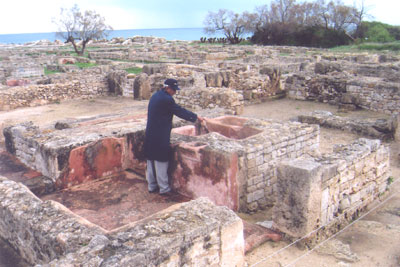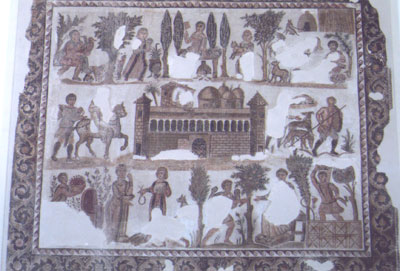Tunisian Odyssey: The beginning
This item appears on page 59 of the July 2010 issue.
by Julie Skurdenis (First of three parts)
This was not my first trip to Tunisia. I had visited the country twice before years ago, but both trips had been brief additions to other trips. I had waited a long time for the opportunity to revisit this relatively small North African country wedged between two much larger neighbors, Algeria and Libya. I also wanted to share Tunisia with my husband, Paul, who had never visited before.
We carved out the time from our schedules, selected a top-notch company, TunisUSA, and went in February ’10.
City of Dido and Aeneas
Our odyssey began in Carthage, a UNESCO World Heritage Site (one of six we were to visit on this trip), located a 15-minute drive from central Tunis.
Carthage was where — according to Virgil’s “Aeneid” — Dido, the city’s legendary founder, fell in love with Aeneas, a survivor of the Trojan War. That’s legend. History says the city was founded around 814 BC by Phoenicians from what is now Lebanon and grew to become one of the most important trading centers in the Mediterranean.
Visitors can still see the commercial and military ports that were the source of Carthage’s power and trading prowess as well as the memorial stones of the children the Carthaginians sacrificed to appease their gods.
Eventually, Carthage came into conflict with Rome. Three wars resulted, with Rome eventually the victor in 146 BC. After destroying Phoenician Carthage, Rome built a sizable imperial city of its own atop the ruins, with an amphitheater, theater, circus and enormous baths, the Antonine Baths, whose immense foundations we strolled through.
Dougga, another UNESCO World Heritage Site, occupies perhaps the most picturesque of any archaeological site in Tunisia. Set high on a hillside, Dougga was a Numidian settlement that came under Carthaginian control and eventually under Rome’s.
Visitors can still stroll its streets past villas, triumphal arches, temples and a second-century-AD theater that could seat 3,500. The highlight at Dougga is the superbly positioned Capitol, honoring the triad of Roman gods (Jupiter, Juno and Minerva), overlooking the city and the hills beyond.
Phoenician Kerkouane
Yet another UNESCO World Heritage Site we saw early in the trip was Kerkouane, a city whose appearance is very much in contrast to the grandeur of Carthage and Dougga.
Kerkouane has nothing Roman or imperial about it. It is a purely Carthaginian city of paved streets, squares, houses and shops which had a population of, perhaps, 2,000. Craftsmen and merchants lived there as well as manufacturers of a color called “Tyrian purple,” made from crushed murex, a mollusk.
Instead of immense public baths, Kerkouane’s claim to fame is its private bathrooms, especially the red-colored tubs, found in many of the houses. It’s a city on a down-to-earth human scale that was abandoned probably around 250 BC and never Romanized.
More archaeological sites
The richness of archaeological sites continued: Thuburbo Majus, a Roman commercial city trading in wheat, wine and olive oil, set atop a Carthaginian city itself atop a Numidian settlement; Utica, the first Phoenician city, founded 300 years before Carthage, with Punic-era tombs from the eighth to the fourth centuries BC (one of them still occupied by a teenage girl who died 2,400 years ago); Oudna, with the ruins of impressive Roman villas decorated with mosaics, and Mustis, with Roman temples, an early Christian church and a small Byzantine-era fort.
All of these we visited in just the first seven days of our trip, with plenty of time to explore each site at our own pace.
Paul and I are both archaeological “nuts,” which is why we loaded our trip with the best of Tunisia’s many archaeological sites. But savoring archaeology isn’t the only thing we did.
Other highlights
When we arrived in Tunisia, we headed for Sidi Bou Said, an elegant suburb of Tunis, for four nights. This gave us time for three incomparable highlights of our trip.
The first was Sidi Bou Said, itself, on the Gulf of Tunis, with narrow stepped streets, whitewashed houses with cobalt-blue doorways and grilled windows and bougainvillea. It was full of tourists, but most left at sunset, leaving the town to us.
The second highlight was Tunis’ medina, or Old City, a labyrinth of alleyways and passageways lined with shops and old houses. The way to visit the medina is to first visit with a guide and then return later to plunge in, get lost among the alleys and make discoveries on your own. This medina is also on UNESCO’s World Heritage List.
Third were visits to the Bardo Museum in Tunis, once with our guide and later in the trip on our own. The Bardo houses one of the world’s best collections of Roman mosaics. Mosaics once adorned the Roman villas we visited throughout the trip.
Another highlight in the early part of the trip was our overnight in Ain Draham, set among mountains and cork forests. Snow was on the mountaintops, but we warmed ourselves in the hotel’s thermal spa.
And this was just the beginning…
If you go…
The company we selected, TunisUSA (175 Strafford Ave., Suite One #500, Wayne, PA 19087; 888/474-5502 or 484/754-0086), specializes in travel to Tunisia, although it also offers travel programs to Turkey, India, Malta, Iran, Libya and elsewhere.
Our customized trip of 22 nights included private car, driver, guide-archaeologist, many five-star hotels and some meals. We specified we wanted lots of archaeological sites, with a mix of medinas, souks and museums plus five days at the end of the trip on the island of Jerba.
We left the day-to-day itinerary in the hands of Jerry Sorkin, president of TunisUSA. What he delivered was right on target: lots of Tunisia’s past mixed with a generous sampling of Tunisia’s here and now — all in the company of Hammadi, one of the most knowledgeable guides we have ever had on any trip.
Besides custom trips, TunisUSA offers small-group tours to Tunisia ranging in length from seven to 12 nights, each with a different emphasis, e.g., “Roman Tunisia,” “From the Classics to Contemporary Society” and “Tunisia and Its Jewish Communities: Past and Present.” Prices, without airfare, range from $2,195 for the seven-night “From the Kasbah to the Sahara” to $4,295 for the 12-night “Tunisia: History, Culture and People.”
TunisUSA also works with organized groups with specific interests (environment, architecture or culinary arts, among others) in putting together special itineraries.


